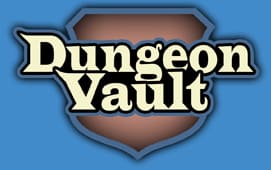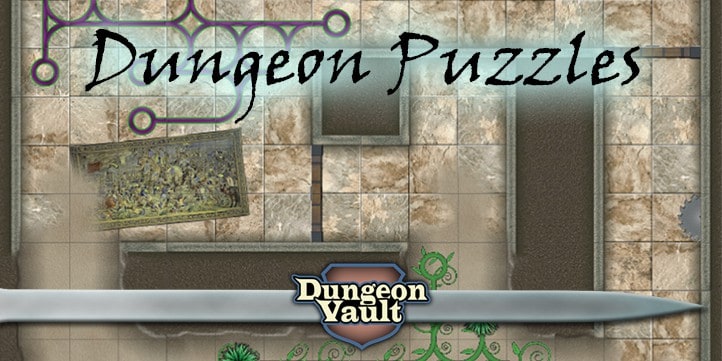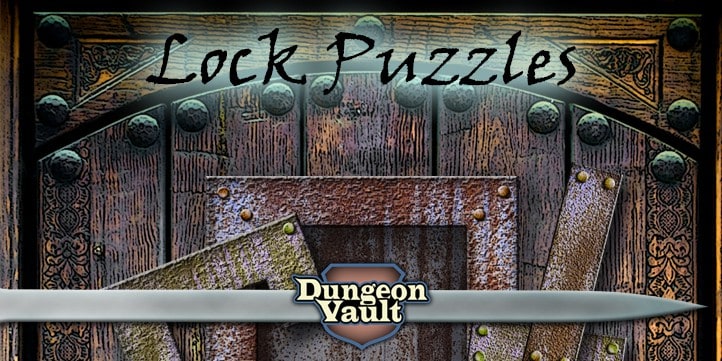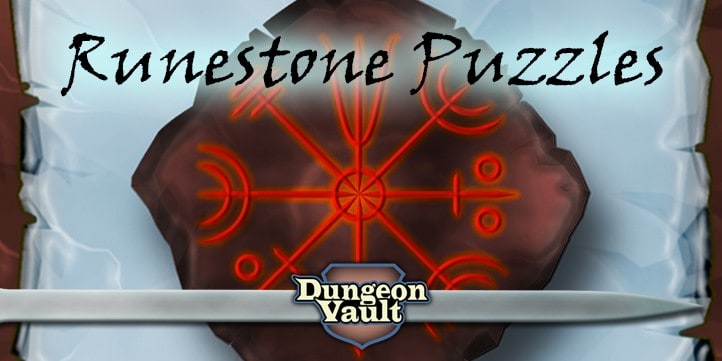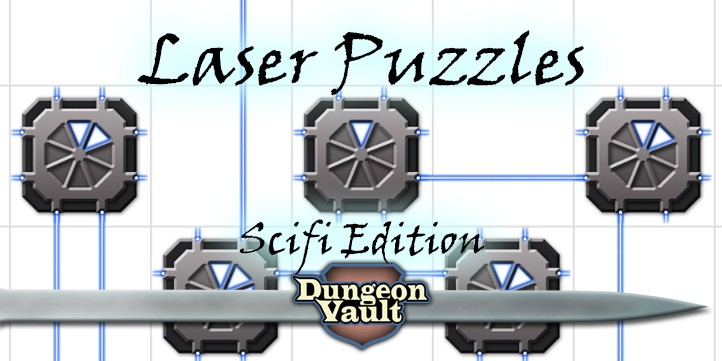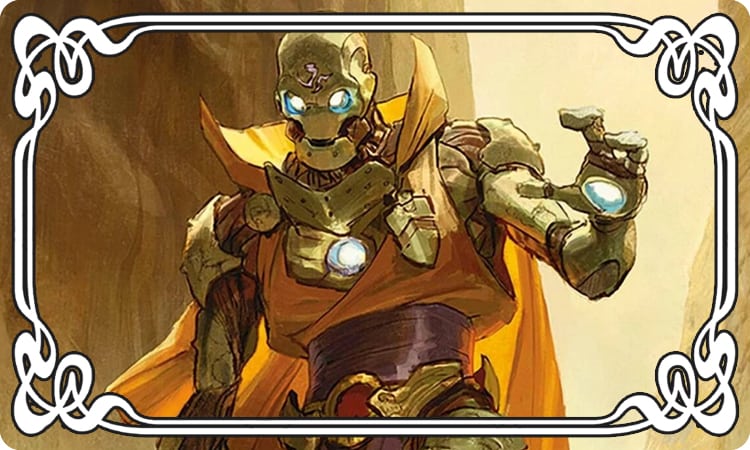
Using Gears and levers in your Dungeons & Dragons puzzles is a sure party favorite. Mechanical D&D puzzles even ranked fourth in our survey of best puzzles. The basics of mechanical puzzle design are simple. You pull a lever or turn a dial and something changes that brings the party one step closer to their goal.
But the real know-how in using mechanical puzzles, is understanding different setups and merging them into ever more challenging combinations. It can get a little overwhelming, but fear not. This complete guide to mechanical puzzles will break this process down for you in super-easy steps.
Basic mechanical puzzle setups
Think of basic setups as the building blocks to a mechanical puzzle that you can mix and match later. In my examples I use levers. But you can change it up by substituting levers with turning dials, stepping stones, turning keys, pulling a rope, etc.
TIP: Work out the mechanical building blocks of your puzzle first, and then change the visuals by substituting levers with an variety of operators. Also, none of the building blocks are original. Uniqueness of your puzzle comes in how you combine these basic elements and in how you reskin them to match your story.
Most puzzles (mechanical or not) have four components:
Clues
A clue can be a piece of information needed to solve the puzzle. Or an object that must be used such as a key. Clues can be collected.
The mechanism
This is the part where you combine the clues to solve the puzzle.
The solution
This is the correct answer to the puzzle.
The outcome
When solved, succesfully something happens in the story that leads players to the next step.
The clues, mechanism, solution, and outcome may vary but if you think about puzzles in these terms they become much easier to seperate an categorize, which is a big help if you’re building more complex setups.
1. The single lever puzzle
The most basic puzzle is a single lever that needs to be pulled. But pulling the lever is not the puzzle, finding the path to getting to the lever is.
To create this puzzle you simply place the lever somewhere out of reach and have players roll multiple climbing and jumping checks to get to it. You can adjust the difficulty by changing the environment.
- Does a single failed check mean PCs have to start their path all over again, or do they get to try again?
- What are the consequences of failing a check? Is the floor lava or a clear pool of water?
TIP: This puzzle becomes more difficult to use once players learn how to fly, use summons or mage hand. You can use countermeasures such as heavy wind against flying, or no direct line of sight against summons and mage hand. But it’s okay to let players use their powers and have their win. You can always add more steps to your mechanical puzzle to make it more challenging.
2. The multiple lever puzzle
Instead of having just one lever, players could have to pull multiple levers simultaneously. This means each player must travel to a different location. It’s a great way to split up the party.
For instance, in a party of 4 there are three players that each need to keep a lever in the down position to open a door. The fourth PC goes through the door and is grappled by a creature. The rest of the party can’t rush in to help because if even one lets go of a lever, gears start grinding and the door immediately closes. Now the puzzle becomes how to keep the door open long enough to help their friend. And time is running out.
Let players creatively try to solve this one. Perhaps they summon an unseen servant to keep the lever in the down position. Or toppling a stone statue against the lever keeps the door opened.
3. The combination lever puzzle
With this puzzle players have to figure out in which pattern a series of levers should be pulled. Or they have to learn which levers, in a series, need to be in the up position or down position. You need to do a little extra work to provide the clues to the combination that solves this puzzle.
For instance, six levers line the wall and each has a symbol of a creature above it. Players can find matching symbols of these creatures either on the ceiling or on the floor. The levers corresponding with the creature symbols found on the floor need to be in the down position, and the symbols of creatures found on the ceiling need to be in the up position.
There are lots of different ways to provide the key to solve the puzzle. It could be as simple as finding a parchment that says: UP, DOWN, DOWN, UP, UP, UP. But you do need to create some plausible key that fits your story.
TIP: It’s not necessary players find all the clues to solving this puzzle. If they only find 4 out of 6 clues to the lever positions, for instance, they can solve the rest through trial and error. So don’t be afraid to make finding the clues challenging.
4. The gear and belt puzzle
The next mechanical puzzle for D&D is the gear and belt turning puzzle. It is basically a puzzle where players turn a lever in one direction and have to reason out in which direction the hand on the final lever turns.
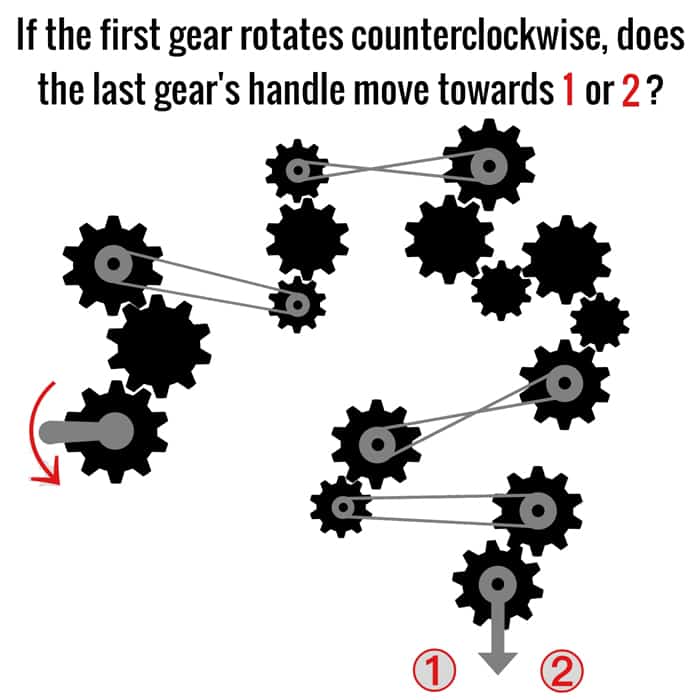
Source: World of engineering
With this setup you can’t use trial and error. Players only get one try and of they get it wrong, there should be dire consequences. That isn’t great for D&D because it keeps the story from moving forward if players get it wrong.
You can easily adjust this puzzle to allow for multiple tries. (The image below shows only the last gear but you would show all the gears to the players obviously). For instance:

With this puzzle the players need to point the hand towards letters in the correct order. In this case they need to spell the word BEHOLDER to solve the puzzle. It works just like opening a safe with a turn dial. This allows for multiple tries and the word that players need to find can match your story.
5. The overlapping gear puzzle
With this puzzle gears overlap and usually carry some item such as a ruby or symbol. Players need to turn the gears so all symbols match a certain pattern.

Source: technifiser
This type of puzzle is used a lot in video games. It doesn’t work as well in D&D because you have to recreate by hand what happens mechanically. This slows solving the puzzle down. (Therefore, it’s not my first choice, but it does belong on this list.)
6. The pipe and wire puzzle
Pipe and wire puzzles are all about connecting currents. These can be electrical currents or flows of liquid. They are not the first thing you might think of when considering mechanical puzzles, but they are mechanical in nature.

Source: technifiser
A variant on this theme is the wire puzzle where players need to follow paths through a jumble of wires to see which ones connect.

Source: machinarium
Most mechanical puzzles are some variant of these basic designs. usually only one or two of the components that make up the puzzle have been changed.
Combining Mechanical puzzle building blocks
None of these puzzles are very impressive on their own. But by combining them we can create something unique.
The puzzles are also relatively easy to solve. That may not seem like a good thing, but it really is. Here’s why: The most popular puzzles in the world – like sudoku or jigsaw puzzles – have many steps to solving them but the individual steps aren’t that difficult. This ensures players continuously experience many small successes which produces a feeling of flow. If you give players a puzzle with just one very difficult step, they feel stuck which does NOT feel good and is the opposite of flow.
So combining your basic mechanical puzzles into grand setups with many solvable steps is what players enjoy most. And it’s no coincidence most video games use this setup. If you look at the history of game design ‘Tomb raider’ was one of the first video games that effectively combined mechanical puzzles with a 3d climbing and jumping environment. Nowadays the graphics have gotten much better, but the puzzle design hasn’t changed much. (Now D&D is not a video game and there are differences we’ll discuss later. But combining puzzles is a favourite across mediums.)
So how do you combine basis mechanical puzzles into more complex setups? I like to use flow charts when combining puzzles, because it keeps things nice and organised.
1. The linear setup
It’s easiest to simply start with a linear setup. Even if you plan to use more complex setups later on, starting with a linear setup and building on it will help you keep an overview.

Players gather enough clues to solve the puzzle, a door opens which leads to the next puzzle, and so on. If you start out with a linear setup, you can always create more complex layouts later. Also, just because your puzzles are laid out linear on your flow chart, doesn’t mean they have to be laid out in a straight line in your game. The first puzzle might be located in the basement of a tower, the second in the attic, the third on a balcony and so on. To the players the puzzles will feel less linear while in reality they are.
For a much more in-depth explanation of laying out puzzles in a dungeon read this article.
TIP: Spread clues around. Even with linear puzzle setups, you can hide the clues around areas players have already explored. For instance, with the combination lever puzzle setup example I used symbols of creatures. But what if this puzzle is located on the ground floor of a building. The players entered through the basement and fought some monsters there. Then they moved to the attic and fought different monsters there. When they come to the combination lever puzzle on the ground floor, the levers that point down correspond to monsters fought in the basement, and the monsters fought in the attic correspond to the up position for levers.
2. The non-linear setup
Non-linear puzzle setups are more complicated. Basically, you add different pathways that all lead to a goal.

There are pros and cons to using this setup. A pro is that if players are unable to solve puzzle 2, they can still try to solve puzzle 3 to achieve their goal. This helps prevent players getting stuck even if they can’t solve a puzzle.
A con is that players can bypass puzzles you’ve created. Creating puzzles is very time consuming for DMs. With the non-linear setup example, players only have to solve half of the puzzles you created.
Personally, I only use non-linear setups if I want to give players a choice that really matters. You can do this by connecting story elements to the different pathways: Solve puzzle 2. and you save the villagers, solve puzzle 3. and you get to avenge your brother, which do you choose? Throwing in a non-linear setup once in a while also helps players from feeling railroaded.
Making mechanical D&D puzzles relevant
A good puzzle is both plausible and relevant to the story. If a lever is placed on the ceiling, it needs to have a reason for being there. Trying to answer these questions after you have created a setup can help you develop your story. And if there is no plausible explanation for placing the lever on the ceiling, place it somewhere else or change the type of puzzle. Your flow chart will still work.
In a cave where giants live, you could create a massive lever that is harder to flip, or switch out the lever for a stepping stone that requires enough weight. A Sahuagin lair might have a lever placed in a pool underwater and so on.
Setting up a flow chart with basic puzzles should only take five to ten minutes. Coming up with plausible and original ways to present your puzzles is usually the most work.
Try as you might, one of the biggest cons of mechanical puzzles is that players will probably have seen it all before. Video games are simply a better medium for using mechanical puzzles because they can more easily show 3d layouts and program complex puzzle setups.
As a storytelling medium, Dungeons and Dragons has different strengths. And therefore different types of puzzles tend to work better with D&D. That doesn’t mean you should never use mechanical puzzles. But you can combine them with different types of puzzles that work better with Dungeons and Dragons. Here are some suggestions:
The mechanical dungeon
I created a puzzle pack called Dungeon Puzzles where the entire dungeon IS the puzzle. With this setup the tiles that make up the hallways and rooms of a dungeon are all pointing in the wrong direction. Players can rotate those parts mechanically to match up all the hallways. Only if all hallways match, can they enter the dungeon.
This puzzle works well with D&D because in solving the puzzle, players are also laying out the map of your dungeon. And when they are finished you can immediately start playing on the layout they have just created. Of course, you can place more puzzles in the dungeon itself. But having the entire dungeon be the puzzle is something most players haven’t seen before.
Lock puzzles
With lock puzzles players need to fill out multiple slots with iron keys. Filling one slot is easy but there is only one way to fill all slots simultaneously.
This puzzle works better with D&D because you can assign one slot to each player. They have to cooperate and trade key pieces to solve this puzzle, which meshes well with the cooperative nature of D&D.
The puzzle has an industrial feel, but the actual mechanics remain hidden in this puzzle. You can place door puzzles onto any object, gas canister, crane or whatever mechanical construction you wish.
Runestone puzzles
With runestone puzzles players must collect runestones and place them on a board in such a way that all symbols match. You can add gears to the backs of these stone so they rotate to unlock a mechanism.
With this puzzle pack you can create an infinite amount of puzzles. Players can collect up to 27 different runestones and may sometimes need multiples to solve puzzles. So you can lay out different puzzles across a campaign easily and control progression through the story.
Laser puzzles
For your high tech mechanics I like to use laser puzzles. With this puzzle players must link up lasers in the correct way. You can use laser puzzles to close a door, but it could also represent the controls of a flying ship, a mechanical weapon, a warforged ally, or the contraption of an artificer that just never worked right.
The Vault Bundle
All my puzzle packs are easy to set up and are fit for tabletops and virtual tabletops. You can combine them with simple mechanical puzzles in bigger setups. For my complete collection check out the vault bundle. It contains all my puzzles and a ton of extras.
By: Paul Camp
